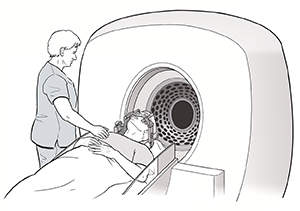What is radiosurgery?
Radiosurgery (stereotactic radiosurgery) is a very precise form of therapeutic radiology. It's not actually surgery. Instead, very focused beams of radiation (gamma rays, X-rays, or protons) are used to treat cancer tissues. No surgical cut (incision) is made.
Radiosurgery is called surgery because it is a 1-session radiation therapy treatment that creates a similar result as a surgical procedure.
How does radiosurgery work?
Radiosurgery works in the same way as other types of therapeutic radiology. It changes or destroys the DNA of tumor cells, so they can't reproduce and grow. Over time, the tumor will shrink in size. For blood vessel lesions, such as an arteriovenous malformation, the blood vessels close off over time after treatment.
What are the types of radiosurgery?
There are 3 types of radiosurgery. Each type uses different equipment and radiation sources.
 |
| Gamma knife. |
Cobalt60 systems (Gamma Knife)
Cobalt60 systems use cobalt as a source for gamma rays. This type of system is often called the Gamma Knife. The Gamma Knife is not really a knife at all. It uses beams of highly focused gamma rays to treat small and medium lesions in and around the brain, such as brain tumors or AVMs. AVMs are abnormal connections between arteries and veins. With Gamma Knife, many beams of gamma radiation join to focus on the lesion under treatment. They provide a very intense dose of radiation in a safe way. The Gamma Knife is also used to treat functional problems, such as trigeminal neuralgia. During treatment, the equipment doesn't move. Gamma Knife treatment often includes these steps:
-
Head frame placement. To keep the head from moving during treatment, a box-shaped frame is attached to the head. Pins designed specifically for this purpose fasten the head frame to the skull. The head frame also is a guide to focus the gamma ray beams to the exact place of the lesion being treated.
-
Tumor location imaging. Once the head frame is in place, the exact location of the lesion to be treated will be found using a CT scan or MRI.
-
Radiation dose planning. After the CT scan or MRI has been done, the radiation therapy team will figure out the treatment plan. A medical physicist will use the imaging scan results, along with other information, to find the best treatment.
-
Radiation treatment. After being positioned for the treatment, a type of helmet with many hundreds of holes in it is placed over the head frame. These holes help to focus the radiation beams on the target. Treatment will last a few minutes up to a few hours. This depends on the type and location of the area being treated. Often, only 1 treatment session is needed for a lesion.
Linear accelerator (LINAC) systems
Linear accelerator (LINAC) systems use high-energy X-rays to treat large tumors or other lesions outside of the brain. Some common types of LINAC systems include:
-
CyberKnife
-
X-Knife
-
Novalis
-
Peacock
Unlike the Gamma Knife, LINAC systems don't use radioactive material to make the radiation. And with LINAC systems, the machinery moves around the person during treatment. So LINAC systems can treat larger tumors and larger affected areas than the Gamma Knife. Areas other than the brain can be treated with a LINAC system. These systems may also be used for external beam radiation therapy. Treatment steps with a LINAC system are often the same as or a lot like the treatment steps used for the Gamma Knife.
Proton beam therapy
Proton beam therapy is a type of particle beam radiation therapy. It does not use rays of radiation, like gamma rays or X-rays. Instead it uses particles, like protons or neutrons.
Proton beam therapy is the most widely used type of particle beam therapy. It is useful in treating tumors or lesions that are small or have an irregular shape. The radiation dose can be more closely controlled with these systems. The proton beam can be controlled so that it places its energy almost completely in the tumor or lesion being treated. Other forms of radiation lose energy as they enter body tissues on their way to the tissue under treatment. The proton beam's depth can be controlled precisely. So there is less damage to normal tissues around the area being treated.
Proton beam therapy may be used for radiosurgery procedures. Or it can be used when several smaller doses of radiation are given over a certain period of time (fractionated radiotherapy).There are only a few facilities in North America that provide proton beam therapy.